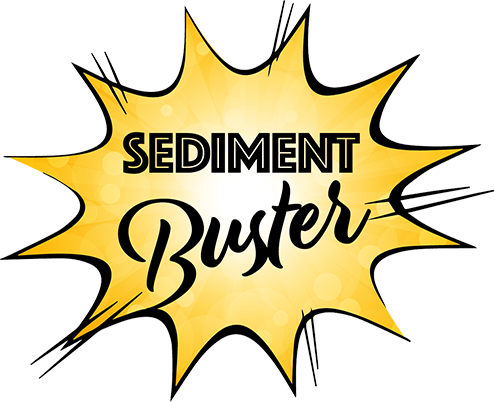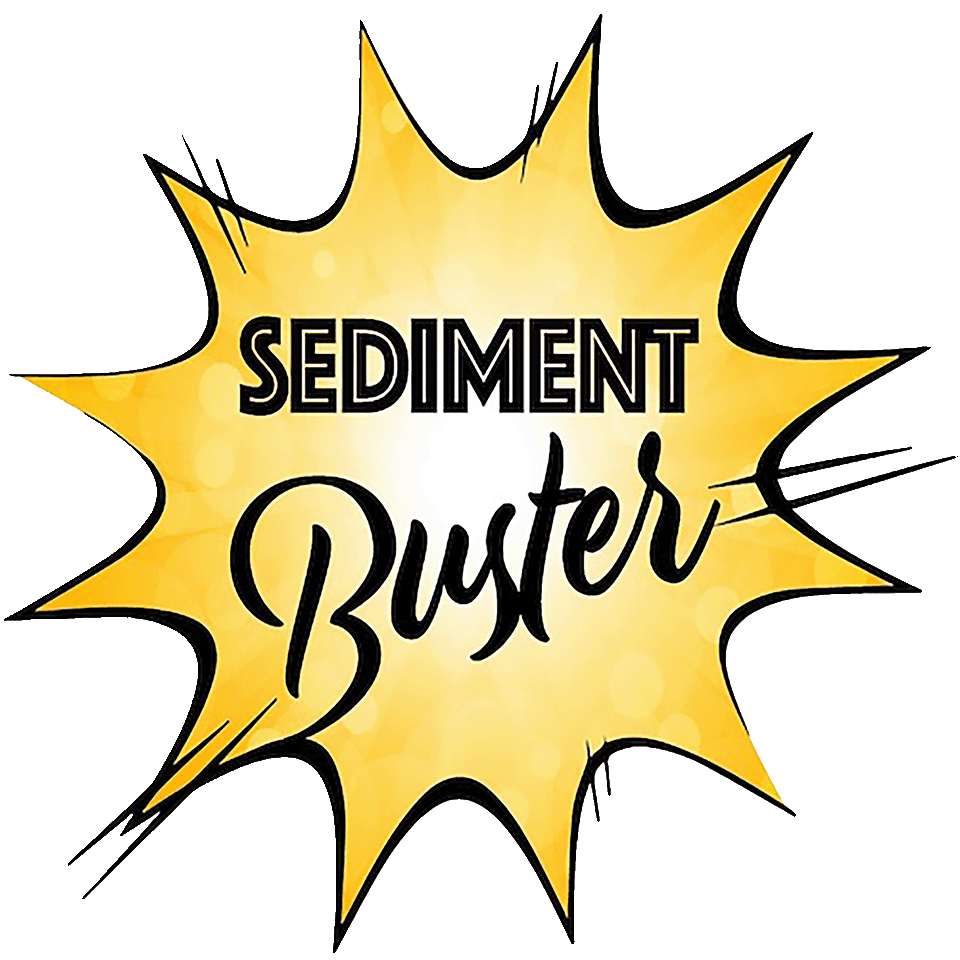Questions & Answers
Frequently Asked Questions
Select a category of questions below:
The recommended PSI is 80 PSI at a water temperature of 100°F. Each Sediment Buster® is factory-tested at 120 PSI and has passed UL verification up to 100 PSI. Importantly:
- If the water heater tank is vented (for example, with a hot faucet open), excess air escapes, so “over-inflating” is impossible.
- Residential water heaters are designed with a T&P (temperature & pressure) valve that opens at 150 PSI to protect the system.
- Short bursts of air are all that’s needed to break up sediment — not continuous, high pressure.
The science behind it:
Water is incompressible, while air is compressible. When you inject air into a water-filled tank, the air disperses and bubbles upward, creating agitation but not a dangerous buildup of force. Because the pressure naturally equalizes through open faucets or the drain valve, the tool is extremely safe to use.
This is mainly for safety — 100°F is warm enough to help flush sediment but not hot enough to cause burns. You can easily achieve this by running hot water for a few minutes until the tank cools and refills with cold water. Since the dip tube delivers incoming water directly near the drain valve, the tank will cool quickly.
No. Household plumbing and water heaters are built to withstand far more pressure than the Sediment Buster® uses. With venting and the tank’s T&P valve as safeguards, there’s no realistic scenario where damage could occur from following the directions.
1) We first recommend removing and cleaning your aerator of the faucet. If you notice heavy debris trapped that may be the problem.
2) If this does not fix the problem, it is likely that your fixture (faucet) needs to be replaced. Replacing the fixture along with the trim lines will often do the trick.
Yes. While some raw parts are sourced globally, all assembly, pressure testing, packaging, and shipping take place in Florida, USA. Every unit is tested before leaving our facility.
It is designed specifically for water heater tanks. Tankless water heaters use different descaling methods (usually vinegar flush kits). We do not recommend using the Sediment Buster® on other appliances.
No — you can use any pump: foot pump, hand pump, or electric compressor. The tool is versatile and does not require high-tech equipment.
1) When you simply open a drain valve, sediment often clogs the outlet, slowing or stopping flow. Sediment Buster® injects short bursts of air, stirring sediment into suspension so it flushes out with the water. Think of it like stirring sugar at the bottom of a glass — agitation is what makes it flow.
2) When using the Sediment Buster® to clean and drain the tank, the pulsing of the air into the tank also acts as a siphon to lift and pull sediment and water as it is draining
3) Plumbers who need to drain the tank quickly have found success adding head pressure to the tank to accelerate the draining process.
The clear see-through eyesight lets you see what’s being flushed out — whether it’s sand, calcium chunks, or rusty sediment. For plumbers, this provides visual proof of progress without guessing.
Sediment forms from minerals (like calcium carbonate), dirt, and debris naturally present in water. Over time, these settle at the bottom of the tank, reducing efficiency and sometimes harboring bacteria.
Yes — and we’ve seen it firsthand. When tanks go unflushed, we’ve captured water coming out dark, slimy, and thick — what’s known as bacterial biofilm. Over time, stagnant sediment at the bottom of a tank becomes the perfect breeding ground. Here’s what can be inside:
- Bacterial biofilms coating layers of sediment
- Iron bacteria, common in Florida groundwater and well systems
- Slimy green/black sludge — a mix of bacteria, mineral oxides, and corrosion
- Sulfur bacteria that contribute to foul odors and discoloration
Why it happens:
Electric water heaters heat from the top down. If sediment buries the lower heating element, the water at the bottom never gets fully hot — often lingering at 85–95°F, which is the perfect temperature range for bacteria to thrive.
Key takeaways:
- Filtration systems alone do not stop bacteria from forming inside a tank
- Not flushing your heater reduces efficiency and creates long-term plumbing and health risks
- Regular flushing with the Sediment Buster® clears out sediment before biofilms can form, keeping your tank cleaner, safer, and more efficient
At least once per year. If you live in a hard-water area, every 6 months is ideal. Regular maintenance extends the life of your water heater and reduces energy costs.
Yes. Sediment can corrode heating elements, clog valves, insulate the tank floor, and cause overheating. Many of the 7 million heaters replaced each year are lost to damage from unflushed sediment.
That’s where the Sediment Buster® shines — it was invented to clear blockages at the drain valve. If the valve itself is too restrictive (common in older plastic valves), replacing it with a brass full-port ball valve is recommended for long-term performance.
- Plastic wheel gate valves → Small opening, most restrictive, prone to leaks.
- Angled gate valves (brass/plastic) → Slightly better, but still narrow.
- Straight line brass valves → Dependable, but ports can still be modest.
- Full-port brass ball valves → Best option, with the widest port (up to 5/8″), allowing chunks of sediment to pass freely.
For maximum effectiveness, pair the Sediment Buster with a full-port valve.
It was invented by John Verhoff, a licensed master plumber who grew frustrated with clogged water heaters that wouldn’t drain. He patented the design (U.S. Utility Patent 11084044 B2) and partnered with Joel Sprecher to bring it to market.
Yes. Many plumbers now use it as a standard tool when replacing or maintaining water heaters. It saves time, avoids extra labor, and provides peace of mind to customers.
Absolutely. If you can hand-tighten a fitting and use a pump, you can use the Sediment Buster®. We provide step-by-step instructions and videos to make the process foolproof.
See our Where to Buy page for more information!
Can't find what you're looking for?
Reach out--we're happy to help!

